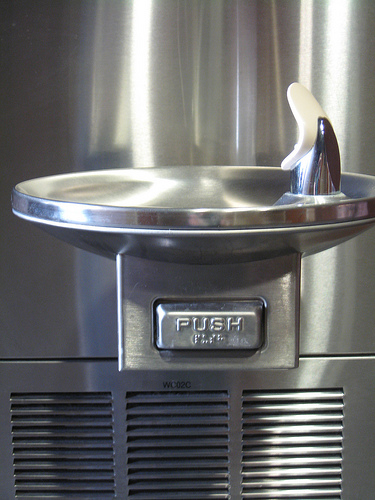Get the lead out, UNB.
That’s the sentiment shared by an environmental and natural resources project group. Their recent study into water fountains on the University of New Brunswick campus showed concentrations of lead exceeding the health advisory level.
The group’s study displayed high levels of lead and iron in fountains found in Bailey Hall and the Forestry and Geology Building. The study was conducted through a water conservation class in the Environmental and Natural Resources faculty as a term project. However, as fourth-year student and group member Jennifer Nicholson explained, the results were unexpected.
“The goal was to go around and check all the water fountains and prove that they are just as good as bottled water, but the results came back a little different than what we thought they would be,” Nicholson said.
“They were a few water fountains in the older buildings, Bailey and Forestry, that showed high levels of lead and iron. We retested the ones that were over the health advisory level and all of them came back under the health advisory level except for one fountain in Bailey Hall.”
The sample showed a concentration just over 0.0015mg/L, the level advised by Canadian health officials. The study group cited old pipes found in the older buildings on campus as reasons for the higher concentration of metal.
Although the levels found in the majority of fountains are nowhere near fatal, third-year student and group member, Amos Champion noted that time plays a factor.
“It’s the higher concentrations that are the worst. You need so much iron a day, but when you drink eight cups of water a day and these fountains have high concentrations of iron, there might be a problem after a while.”
In checking for consistency in their samples, the group came across a rather interesting occurrence upon running the water.
“We sampled differently than what we did the first time,” explained second-year student Hannah Bradford. “We used a time sequence. We took a sample at five seconds then took a sample at two minutes then we took a sample at five minutes after letting the water run. We found that the levels of lead and iron decreased dramatically within the first two minutes.”
Champion recommended students, especially in the morning, run the water to flush out the pipes before filling up their water bottle.
The group immediately brought the study to the attention of the university before the holiday break.
Mike Carter, director of facilities management for UNB, said the university is committed to ensuring there is a high quality of drinking water on campus and launched an investigation upon hearing the recent developments.
“To date we have had discussions with the NB Department of Health, the Department of Environment and the City of Fredericton on this issue and are retaining the services of a consultant to help us investigate. I have now received the results of the sampling done by students in Bailey Hall and will use them in the investigation over the coming weeks.”
Along with informing the university about their findings, the group made three recommendations. Firstly, to have employees go around and flush out the fountains for five minutes every morning. Secondly, put filters in every fountain to help catch the metals. Finally, the university should ultimately replace the pipes in the older buildings.
The group is also promoting the installation and use of hydration stations around campus. These new fountains allow students to easily fill their water bottles, while eliminating the appearance of metals due to a high-level filtration system. The new stations are also more accessible.
“The new fountain installed near the UNB Science Library included the installation a filling station to provide refrigerated filtered water, but it also has an accessibility benefit as well,” said Carter. “A bi-level fountain was chosen for this location to make the lower fountain barrier free for people accessing it from a wheelchair.”
Carter is currently monitoring the popularity of the fountains to gauge the possibility of further installations.
“The popularity of the water bottle filling stations will determine if they will be added to future fountain installations, of course pending funding approval. The cost to supply and install one refrigerated water fountain with a bottle filling station can cost in the order of $5,000 to $6,000 depending on the location where it is to be installed in the building.”
This article was first printed in the Brunswickan, Canada’s oldest student newspaper.




